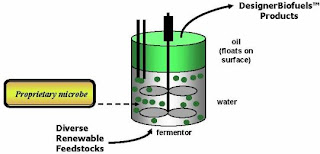Peak Oil: Meet Synthetic Micro-Organisms that Produce Petroleum
 Creating micro-organisms that can synthesise renewable hydrocarbons for fuels and feedstocks, is one aim of synthetic biology.
Creating micro-organisms that can synthesise renewable hydrocarbons for fuels and feedstocks, is one aim of synthetic biology.The process is the same as making cellulosic ethanol insofar as cellulosic feedstocks are converted into fermentable sugars, and those sugars are placed in a fermentation vat. The difference comes in the microbes doing the fermenting. With ethanol, it's generally some form of yeast. The researchers at LS9 have engineered their own microbes, lifting genes from other microbes and recombining them into an organism that does just what they want. In this way they can precisely tweak the characteristics of the resulting fuel.Source
Yeast fermentation produces ethanol, which mixes with water and subsequently has to be extracted via distillation. LS9's microbes produce -- via fatty acid metabolism, in a process I won't claim to understand -- hydrocarbons (the building blocks of petroleum). These hydrocarbons are immiscible, i.e., they don't mix with water. Instead, they float to the top of the vat, where they can essentially be skimmed off. That allows LS9 to skip the distillation process, which saves a whole boatload of energy. (That's where most of the claimed 65% energy savings comes from.)
David Berry, one of the brains behind LS9, has won the Young Innovator of the Year award from MIT's Tech Review.
Berry's goal was nothing less than "to develop a novel and far-reaching solution to the energy problem." In collaboration with genomics researcher George Church of Harvard Medical School and plant biologist Chris Somerville of Stanford University, Berry and his Flagship colleagues set out to do something that had never been attempted commercially: using the tools of synthetic biology to make microörganisms that produce something like petroleum. Berry assumed responsibility for proving that the infant company, dubbed LS9, could produce a biofuel that was renewable, better than corn-derived ethanol, and cost-competitive with fossil-based fuels.Source
I understand that Chris Somerville -- a leading figure in the plant biology field -- is also at work on plants that are genetically engineered to produce biodegradable plastics. Now if they could just integrate that idea with these petroleum-producing microbes, we'd really have something to celebrate.
If synthetic biologists can create microbes that efficiently create "petroleum" in an industrial environment--out of renewable materials and skipping any energy-wasting distillation process--the economics of the future of energy might change a bit.
Labels: Energy Technologies, peak oil, peak oil 2, synthetic biology

5 Comments:
It would still require arable land. Algal biopetroleum is a better bet.
My take.
If your feedstock is cellulose, you can grow kudzu for your raw material. No cultivation required, and the product can also be used as livestock feed.
A lot of biofuel crops can be grown on marginal land with minimal cultivation, no fertilizer, no pesticide, etc.
Part of the bad rap for biofuels is the disastrous use of maize for ethanol. Probably the worst possible approach.
You could combine in a photosynthetic bacteria and grow fuel in tanks over water.
Interesting idea, a.c.o.
A symbiotic culture of micro-organisms. One photosynthetic organism providing the feedstock for another organism to produce fuels or other feedstocks. All in the same--or communicating--cultures.
Another for extending "arable land" might be high rise aeroponics. Such novel food growing facilities could provide most of the food for urban centers, without using farmland or requiring expensive transportation resources.
Crops for biofuels can often "grow like weeds" on land that no self-respecting food crop would grow on.
"If your feedstock is cellulose, you can grow kudzu for your raw material. "
Right now, that's a really big "if." To my knowledge, there's been no real progress in the arena of breaking down complex sugars into an energy-convertible material at anything resembling a worthwhile exchange rate.
There's another aspect which is (mildly) concerning: should any such process be achieved bacterially, such bacteria would have available a nutrient resource that nigh-unto no other bacteria consume -- at least, not at the scales what we're discussing would. That means that it could outcompete and thus become a biohazard, if escaping containment. The algae species used for algal biopetroleum have exactly the opposite problem; they must be kept isolated from non-modified algae populations in order to ensure they are not outcompeted by the natural stuff: hence, no biohazard.
And you still have to factor in the expected "gallons-per-acre" of roughly 2,000. While non-arable land would open that up to roughly 50% instead of 18% of the available landmass in the US (I'm US-centric, and admittedly so) -- it's still nowhere near comparable to what you could accomplish with algal biopetroleum -- which essentially is the photosynthetic bacteria that "A.C.O" hypothesized. It's raw numbers: 20k-100k /acre or .5k-2k/acre.
Either way; ethanol (rather than 'bio-gasoline' or 'bio-diesel') as a solution is a joke.
Post a Comment
“During times of universal deceit, telling the truth becomes a revolutionary act” _George Orwell
<< Home